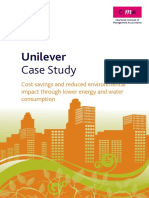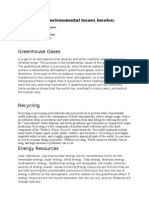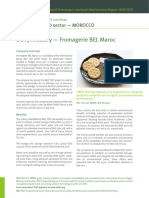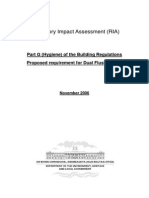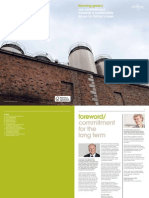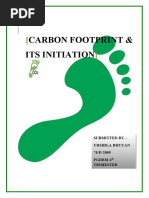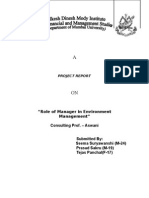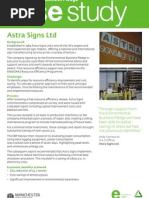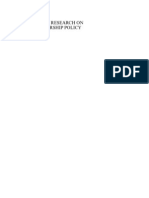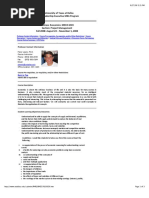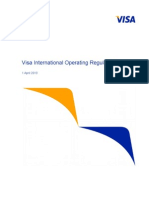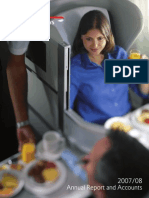At A Glance The Green Seafood Business Programme Project Description
At A Glance The Green Seafood Business Programme Project Description
Uploaded by
api-286562658Copyright:
Available Formats
At A Glance The Green Seafood Business Programme Project Description
At A Glance The Green Seafood Business Programme Project Description
Uploaded by
api-286562658Original Title
Copyright
Available Formats
Share this document
Did you find this document useful?
Is this content inappropriate?
Copyright:
Available Formats
At A Glance The Green Seafood Business Programme Project Description
At A Glance The Green Seafood Business Programme Project Description
Uploaded by
api-286562658Copyright:
Available Formats
At a Glance
BIM introduced a pilot programme
to seven seafood companies
looking at reducing environmental
inputs.
2010-ET-CP-21
Project Description
The Green Seafood Business Programme
The project was implemented through
the conduction of environmental
reviews and recommendations for
improvements. The surveys identified
areas and alternative work practices
that could be implemented to reduce
the input of water and energy.
The largest and most costly waste
streams of the sector are water and
energy consumption through
inefficient processes and utilisation.
The programme involved
environmental audits, installation
of monitoring equipment and
building on-site awareness of the
opportunities for improvement.
The programme outcomes were
achieved through leak detection
and efficiencies within process
water and cleaning water.
A company can expect to
reduce water consumption to
3
3
between 800m and 6,400m per
year resulting in
1,000 to 14,500 annualised cost
savings.
The Energy savings are in the
thousands of euros in terms of
improving energy management e.g.
company saved 1,000 a month on
wattles charges simply by replacing
a fault capacitor. Further work on
this is on-going.
A key position for Irish Seafood
Sector is to enhance the credentials
of Clean Green and Sustainable.
Water:
Bord Iascaigh Mhara
BIM, Crofton Road, Dun Laoghaire,
Co. Dublin, Ireland.
www.bim.ie
Bord Iascaigh Mhara (BIM) was
established under the Sea Fisheries Act of
1952 and is the state agency with
responsibility for the development of the
seafood industry, including sea fishing,
aquaculture and the seafood processing
sector.
To facilitate the programme in-line Wifi
water meters were installed as a
management tool. This allowed
companies to identify when there was
an increase in usage.
A follow-up audit was undertaken to
determine the level of change and to
give feedback to the companies on
outstanding or further development
that could be achieved.
3 water meters on site monitored
The sector comprises 130 seafood
processing establishments ranging from
small artesian processors to large multi
million euro business, with a range of
products across pelagics, whitefish,
salmon, shellfish and ready-to eat
products.
Aims of this project
The main aim of this CGPP project was to
reduce water and energy costs within the
seafood processing sector.
The aims were to be achieved by:
better monitoring and management
of those utilities,
to build awareness to highlight the
benefits of better environmental
management and
to develop a green image for the Irish
seafood processing sector consistent
with the agri-food policy Food
Harvest 2020.
Energy
Energy efficiency centred on
refrigeration and the adoption of
fundamental management issues to
improve efficiencies in chills and cold
rooms.
Outcomes
Gains / Impacts
The following is a summary of the
environmental and economic benefits
from this project:
Basic detection of leaks at incoming
stage, including the number of meters
is the starting point that yielded
improvements for most companies.
The leak detection begins at the
meter level, as in most cases
significant water leaks were detected
at this point.
The second stage of detection moves
to within the plant, where significant
savings can be achieved, anything up
to 5000 worth of water on repairing
leaks and zeroing the companies
background water use.
The third area for water reduction
was in the cleaning stage which uses
about 38% of overall water usage.
The clear outcome is that changes in
the cleaning procedures can
significantly reduce water utilisation
and costs.
The fourth outcome is to look at
water utilisation with the process,
especially refrigeration coolant
systems that use significant amounts
of water.
Doing a Water Balance
The overall savings and reductions in
water and energy usage varied
between the establishments.
The average water reduction at the
individual processor level varied
3
3
between 800M and 6,400M per
year.
The financial cost savings similarly
varied from 1,200 and 14,500 per
year, based on water charges only.
The energy savings are in the
thousands of euros in terms of
improving energy management. A
company saved 1,000 a month on
wattles charges simply by replacing a
fault capacitor. Further work on this
is on-going.
Lessons
Water and energy reduction are
possible within any plant based
on a number of criteria been in
place.
Company commitment to assign
necessary time
Installation of a remote monitoring
devices essential.
Training and mentoring of company
staff.
Develop a small pocket booklet that
could be given to key maintenance
staff in conjunction with an onsite
training
day
on
effective
environmental management.
Communications via mail shots and
trade press to the rest of the Seafood
processing sector on the merits and
cost benefits of management utility
costs.
A key position for Irish seafood is to
enhance the credentials of Clean Green
and Sustainable.
More Information and Contact:
The Green Seafood Business Programme
was funded by BIM and the EPA Cleaner
Greener Production Programme.
Paul Ward
BIM, Crofton Road,
Dun Laoghaire,
Co. Dublin
Tel +353 (0)1 2144100
The Cleaner Greener Production
Programme (CGPP) of the EPA is funded
under the National Development Plan 20072013. The CGPP was launched in 2001 as a
grant scheme to fund Irish organisations to
implement cleaner greener practices while
achieving significant cost savings.
Cleaner Greener Production is the
application of integrated preventive
environmental strategies to processes,
products and services to increase overall
efficiency and reduce risks to humans and
the environment.
Production processes: conserving
raw materials and energy, eliminating
toxic raw materials, and reducing
the quantity and toxicity of all
emissions and wastes
Products: reducing negative
impacts along the life cycle of a
product, from raw materials
extraction to its ultimate disposal.
Services: incorporating
environmental concerns into designing
and delivering services.
The programme aims are focussed on
avoiding and preventing adverse
environmental impact rather than treating
or cleaning up afterwards. This approach
brings better economic and
environmental efficiency.
The CGPP is funded by the EPA STRIVE and
NWPP programmes
Additional case studies from companies that
participated in CGPP are available on our
website (www.cleanerproduction.ie),
including:
A full technical report for each project
Programme brochures, summarising all
projects funded under CGPP
More information on CGPP is available from
the EPA:
Lisa Sheils
Environmental Protection Agency,
Richview, Clonskeagh,
Dublin 14, Ireland
Tel: +353 (0)1 2680100
http://www.epa.ie/researchandeducation/research
You might also like
- Getting To Yes - Negotiation Agreement Without Giving in by RogerDocument16 pagesGetting To Yes - Negotiation Agreement Without Giving in by RogerAnonymous 45z6m4eE7p100% (3)
- Case Study (WTO - Thailand Tuna Fish)Document30 pagesCase Study (WTO - Thailand Tuna Fish)Ahmer Ali100% (1)
- Waste Reduction Programme Focused On Process Technologies at Connacht Gold Dairy Ingredients (Shannonside) Project DescriptionDocument2 pagesWaste Reduction Programme Focused On Process Technologies at Connacht Gold Dairy Ingredients (Shannonside) Project Descriptionapi-286562658No ratings yet
- cgpp4 15 SupermacsDocument2 pagescgpp4 15 Supermacsapi-286562658No ratings yet
- MED TEST - Tunisia: The Case StudiesDocument30 pagesMED TEST - Tunisia: The Case StudiestsakiriNo ratings yet
- CGPP Phase 2 BrochureDocument32 pagesCGPP Phase 2 Brochureapi-286562658No ratings yet
- 2010 ET-CP-19 Logistics Optimisation and Energy Optimisation For Jack Cuthbert's BakeryDocument2 pages2010 ET-CP-19 Logistics Optimisation and Energy Optimisation For Jack Cuthbert's Bakeryapi-286562658No ratings yet
- MED TEST: Transfer of Environmental Sound Technology in The South Mediterranean Region - Egypt Case StudiesDocument26 pagesMED TEST: Transfer of Environmental Sound Technology in The South Mediterranean Region - Egypt Case StudiestsakiriNo ratings yet
- cgpp4 9 Cit - SummaryDocument2 pagescgpp4 9 Cit - Summaryapi-286562658No ratings yet
- CGPP2004/2: Moving Towards A More Sustainable Fish IndustryDocument2 pagesCGPP2004/2: Moving Towards A More Sustainable Fish Industryapi-286562658No ratings yet
- Scho1209brnz e e PDFDocument76 pagesScho1209brnz e e PDFmunawarNo ratings yet
- cgpp5 22 Cope Summary For WebDocument2 pagescgpp5 22 Cope Summary For Webapi-286562658No ratings yet
- Web Recp Indicator PeruDocument12 pagesWeb Recp Indicator PeruLeigh EscuderoNo ratings yet
- Social Responsibility Report 2009Document58 pagesSocial Responsibility Report 2009Anup VermaNo ratings yet
- Unilever: Case StudyDocument2 pagesUnilever: Case StudyNAVANEETH NAVANINo ratings yet
- Water and Chemicals in ProcessingDocument35 pagesWater and Chemicals in ProcessingveselieNo ratings yet
- Itc Case Study: Water Filtration and Waste ManagementDocument6 pagesItc Case Study: Water Filtration and Waste ManagementThabisNo ratings yet
- cgpp2004 20 SummaryDocument4 pagescgpp2004 20 Summaryapi-286562658No ratings yet
- SDG Data FinalDocument2 pagesSDG Data Finalum23375No ratings yet
- Goal 13Document2 pagesGoal 13Main hoon LaHorE -LaHoreEeE Fun & FactsNo ratings yet
- Waste Leather IndustryDocument53 pagesWaste Leather IndustryDwi Bayu Prastyanto100% (1)
- Business EthicsDocument5 pagesBusiness EthicsHimadri NayakNo ratings yet
- Finance - United UtilitiesDocument4 pagesFinance - United UtilitiesRohit DhoundiyalNo ratings yet
- UWS Carbon Management Plan 2010Document44 pagesUWS Carbon Management Plan 2010Chris FindlayNo ratings yet
- Coca Cola Case StudyDocument2 pagesCoca Cola Case Studypuja bhatNo ratings yet
- 3M Virtual Tour (Draft)Document9 pages3M Virtual Tour (Draft)Dipak PatilNo ratings yet
- Danone EconomicsDocument15 pagesDanone EconomicsMiriam UtreraNo ratings yet
- Lankbank EnvironmentalDocument6 pagesLankbank EnvironmentalNikki M. ArapolNo ratings yet
- Greenhouse Gases: Main Environmental Issues InvolveDocument6 pagesGreenhouse Gases: Main Environmental Issues InvolvecameronskimmingsNo ratings yet
- Cleaner Greener Production Programme (cgpp4&5) Business Case Studies 2008-2012Document36 pagesCleaner Greener Production Programme (cgpp4&5) Business Case Studies 2008-2012api-286562658No ratings yet
- Case Study - New ArchidDocument2 pagesCase Study - New ArchidKatherine MurilloNo ratings yet
- Sustainability Practices Followed by IoclDocument3 pagesSustainability Practices Followed by IoclPrince PriyadarshiNo ratings yet
- Tao Wang - World Bank Experience On Carbon Finance Operations in BiogasDocument20 pagesTao Wang - World Bank Experience On Carbon Finance Operations in BiogasEnergy for AllNo ratings yet
- Achieving Sustainable Energy Reduction in An Industrial SettingDocument2 pagesAchieving Sustainable Energy Reduction in An Industrial SettingKit OungNo ratings yet
- Carbon Credit Presentation Peter Greenham IIGIDocument17 pagesCarbon Credit Presentation Peter Greenham IIGIfwrgroupNo ratings yet
- Guidebook On Waste Minimisation For IndustriesDocument27 pagesGuidebook On Waste Minimisation For Industriesnarasimhamurthy414No ratings yet
- Hotel Energy SolutionsDocument14 pagesHotel Energy SolutionsOmar S. Hamdan100% (1)
- Assignment 2 Petroleum PDFDocument5 pagesAssignment 2 Petroleum PDFAdityaNo ratings yet
- 12-50507_Factsheet_BEL_Ebook_0Document2 pages12-50507_Factsheet_BEL_Ebook_0Ams TeslaNo ratings yet
- Greener Manufacturing HandbookDocument11 pagesGreener Manufacturing Handbookjkwilson96No ratings yet
- Freight Forwarder PracticesDocument9 pagesFreight Forwarder PracticestoanvmpetrologxNo ratings yet
- national-action-plan-on-climate-changDocument8 pagesnational-action-plan-on-climate-changGaganNo ratings yet
- Summer Sustainability: University of GreenwichDocument5 pagesSummer Sustainability: University of GreenwichOribuyaku DamiNo ratings yet
- CCRP 3 Timoney Methane LandfillDocument58 pagesCCRP 3 Timoney Methane LandfillSatish GanesanNo ratings yet
- Role of EMA AccountantDocument9 pagesRole of EMA Accountant24424.2024No ratings yet
- How To Optimize Clear in Place CIP ProcessesDocument11 pagesHow To Optimize Clear in Place CIP Processesukal100% (1)
- RIA Part G 2006 (Irish)Document8 pagesRIA Part G 2006 (Irish)Julianna BakerNo ratings yet
- Case Study Cambridge City Council: BackgroundDocument2 pagesCase Study Cambridge City Council: BackgroundpatriciojouiNo ratings yet
- Thinking On Low Carbon Energy Sources - Erlet ShaqeDocument25 pagesThinking On Low Carbon Energy Sources - Erlet ShaqeErlet ShaqeNo ratings yet
- 1Document2 pages1Himadri NayakNo ratings yet
- UNIT3Document13 pagesUNIT3Md. SunmunNo ratings yet
- Better Business in A Better Ireland: Cleaner Sugar Beet ProductionDocument4 pagesBetter Business in A Better Ireland: Cleaner Sugar Beet Productionapi-286562658No ratings yet
- Green ManufacturingDocument8 pagesGreen ManufacturingYabert Yanuar SantosoNo ratings yet
- Brewing GreenDocument10 pagesBrewing GreenHang U LieNo ratings yet
- Sree Sastha Institute of Engineering and Technology: Green Audit ReportDocument11 pagesSree Sastha Institute of Engineering and Technology: Green Audit ReportCandida DhasonNo ratings yet
- Carbon Tax Palmer United Emissions Trading Scheme ETS Policy Conditions and ReviewDocument18 pagesCarbon Tax Palmer United Emissions Trading Scheme ETS Policy Conditions and ReviewfwrgroupNo ratings yet
- Carbon Footprint & Its Initiation: Submitted by - Urshila Bhuyan 70/D/2009 PGDBM 4 TrimesterDocument7 pagesCarbon Footprint & Its Initiation: Submitted by - Urshila Bhuyan 70/D/2009 PGDBM 4 TrimesterManas D BorkakotyNo ratings yet
- MAY 2024 - SUMMARYDocument16 pagesMAY 2024 - SUMMARYperfect.rakhi.007No ratings yet
- "Role of Manager in Environment Management" Consulting Prof. - AswaniDocument11 pages"Role of Manager in Environment Management" Consulting Prof. - Aswaniprasad_885No ratings yet
- Astra Signs LTDDocument1 pageAstra Signs LTDzsolt_vitalNo ratings yet
- Better Business in A Better Ireland: Cleaner Sugar Beet ProductionDocument4 pagesBetter Business in A Better Ireland: Cleaner Sugar Beet Productionapi-286562658No ratings yet
- 2 4Document2 pages2 4api-286562658No ratings yet
- Better Business in A Better IrelandDocument4 pagesBetter Business in A Better Irelandapi-286562658No ratings yet
- Better Business in A Better IrelandDocument4 pagesBetter Business in A Better Irelandapi-286562658No ratings yet
- CGPP2004/2: Moving Towards A More Sustainable Fish IndustryDocument2 pagesCGPP2004/2: Moving Towards A More Sustainable Fish Industryapi-286562658No ratings yet
- Cleaner Greener Production Programme (cgpp4&5) Business Case Studies 2008-2012Document36 pagesCleaner Greener Production Programme (cgpp4&5) Business Case Studies 2008-2012api-286562658No ratings yet
- cgpp2004 3 SummaryDocument4 pagescgpp2004 3 Summaryapi-286562658No ratings yet
- cgpp2004 25 SummaryDocument4 pagescgpp2004 25 Summaryapi-286562658No ratings yet
- cgpp2004 26 SummaryDocument4 pagescgpp2004 26 Summaryapi-286562658No ratings yet
- Schiedel CGPP 2 15 SummaryDocument2 pagesSchiedel CGPP 2 15 Summaryapi-286562658No ratings yet
- David Ausdricht - El EmprendedorDocument250 pagesDavid Ausdricht - El EmprendedorJozch EstebanNo ratings yet
- UT Dallas Syllabus For Meco6303.pi1.08f Taught by Peter Lewin (Plewin)Document3 pagesUT Dallas Syllabus For Meco6303.pi1.08f Taught by Peter Lewin (Plewin)UT Dallas Provost's Technology GroupNo ratings yet
- Luceco Catalogue v8 ENDocument98 pagesLuceco Catalogue v8 ENsunanNo ratings yet
- GEC04 Activity For Lesson 6-JUACALLADocument4 pagesGEC04 Activity For Lesson 6-JUACALLAVien Cedric JuacallaNo ratings yet
- Topic 8 Exer AnswerDocument6 pagesTopic 8 Exer AnswerIrfan AimanNo ratings yet
- XamIdea Economics Class 12Document457 pagesXamIdea Economics Class 12Aaditi V50% (2)
- 4 Guidelines On Taking Public Markets To The Next LevelDocument23 pages4 Guidelines On Taking Public Markets To The Next LevelDoroty CastroNo ratings yet
- Visa International Operating Regulations MainDocument1,218 pagesVisa International Operating Regulations Mainbcooper477100% (3)
- K M Savjani College POOJA AMBUJA PDF PDFDocument51 pagesK M Savjani College POOJA AMBUJA PDF PDFcharmiNo ratings yet
- Role of Agriculture in The Economic DevelopmentDocument2 pagesRole of Agriculture in The Economic DevelopmentSamad Raza KhanNo ratings yet
- Tiger Pro Unloading Manual A1 VersionDocument6 pagesTiger Pro Unloading Manual A1 VersionMuntaserNo ratings yet
- Macroeconomic Money MarketDocument6 pagesMacroeconomic Money MarketKINGS GroupNo ratings yet
- REFERENCESDocument5 pagesREFERENCESAnonymous lPocpGK90No ratings yet
- UDUPIDocument6 pagesUDUPItenthriveNo ratings yet
- Swot & PestelDocument4 pagesSwot & PestelUrvashi Arora100% (1)
- Thayer Vietnam's New Maritime Strategy - Ends, Ways and MeansDocument3 pagesThayer Vietnam's New Maritime Strategy - Ends, Ways and MeansCarlyle Alan Thayer100% (1)
- Hardware Companies - Petaling - MalaysiaDocument23 pagesHardware Companies - Petaling - MalaysiaPacific HRNo ratings yet
- People As Resource One ShotDocument13 pagesPeople As Resource One ShotAzelNo ratings yet
- British Airways Annual ReportDocument136 pagesBritish Airways Annual ReportChitipat Manon80% (5)
- 17 719 BustimesDocument18 pages17 719 BustimessandwichslayerNo ratings yet
- P & G OverviewDocument12 pagesP & G OverviewDakshesh PatelNo ratings yet
- Biker Name: SAMIR SWAIN: InvoiceDocument12 pagesBiker Name: SAMIR SWAIN: InvoiceLalatendu PradhanNo ratings yet
- Direct Tax Vs Indirect TaxDocument7 pagesDirect Tax Vs Indirect Taxsamuel debebeNo ratings yet
- Tata Nano CaseDocument19 pagesTata Nano CasenagenderNo ratings yet
- Unit 2506 Raffles Corporate Center, F. Ortigas Jr. Road, Ortigas Center, Pasig City, Philippines 1605Document2 pagesUnit 2506 Raffles Corporate Center, F. Ortigas Jr. Road, Ortigas Center, Pasig City, Philippines 1605CENTRAL OFFICE ACCOUNTINGNo ratings yet
- Trans5 2019 12Document104 pagesTrans5 2019 12arunmozhiNo ratings yet
- Soacha: Plan de Ordenamiento Territorial: WWW - Sogeocol.edu - CoDocument12 pagesSoacha: Plan de Ordenamiento Territorial: WWW - Sogeocol.edu - CoAndres PinzonNo ratings yet
- KCI Kendilo Coal Indonesia ProfileDocument1 pageKCI Kendilo Coal Indonesia Profilegbh_suryoNo ratings yet














